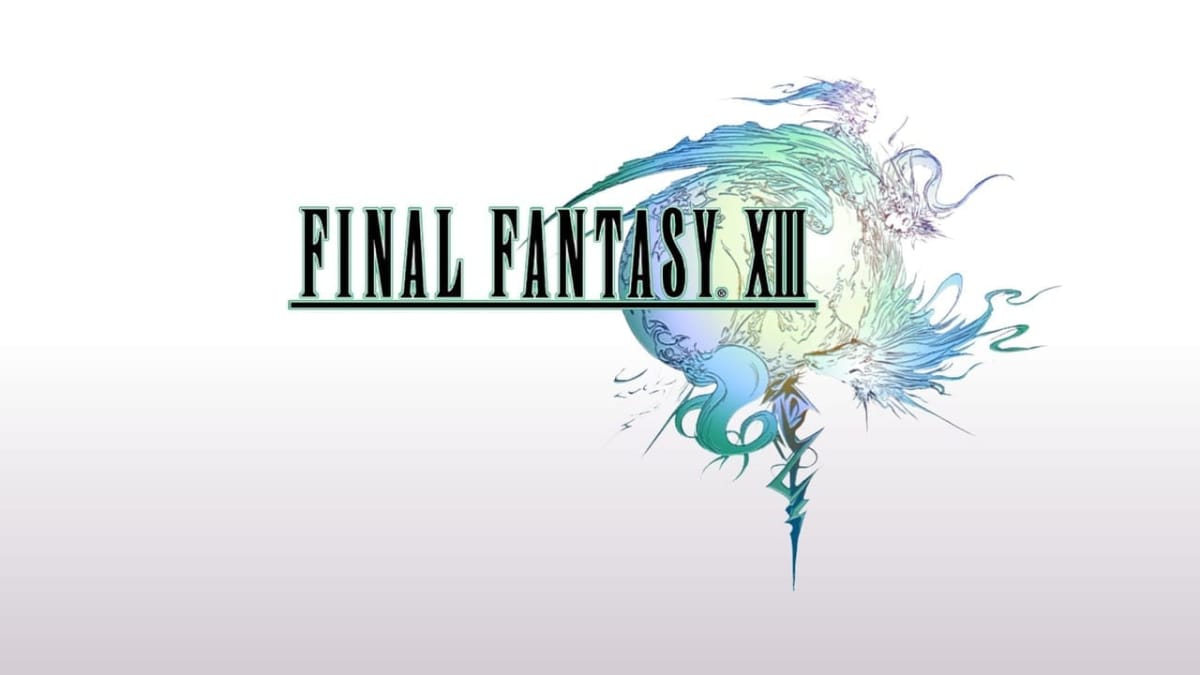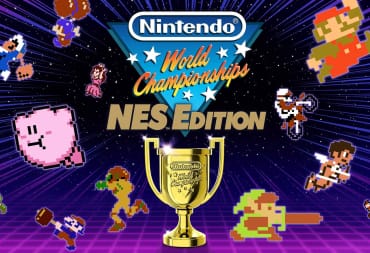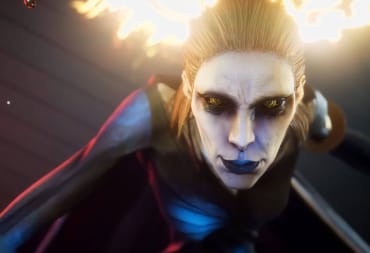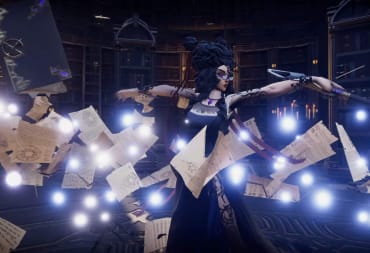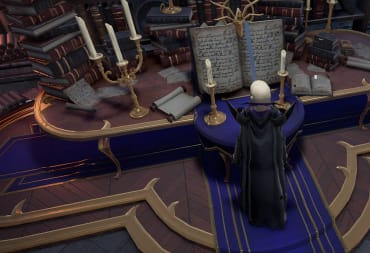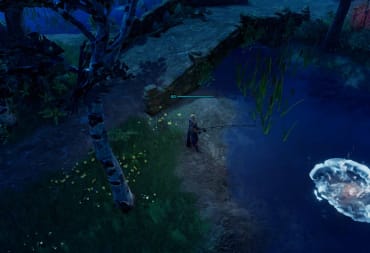Hey there, everyone! Final Fantasy XIII really sucks, am I right? Huh? Who’s with me? High five! See you next month!
This is part of a continuous series. Be sure to check out the other entries of the Year of Final Fantasy!
Okay, not really. That just seems to be the easy answer whenever someone brings up the divisive entry. In fact, I would even go so far as to say Final Fantasy XIII is almost as bloody a war between fans as Final Fantasy VI vs. VII. It’s also exacerbated by the fact that this entry is much more recent than those two, so the heat is turned up a lot more at the current time. Finish off with the fact that Final Fantasy XIII is the only main game to receive two sequels, making fans of other games feel snubbed, and it’s not hard to see why the flame war is so nasty.
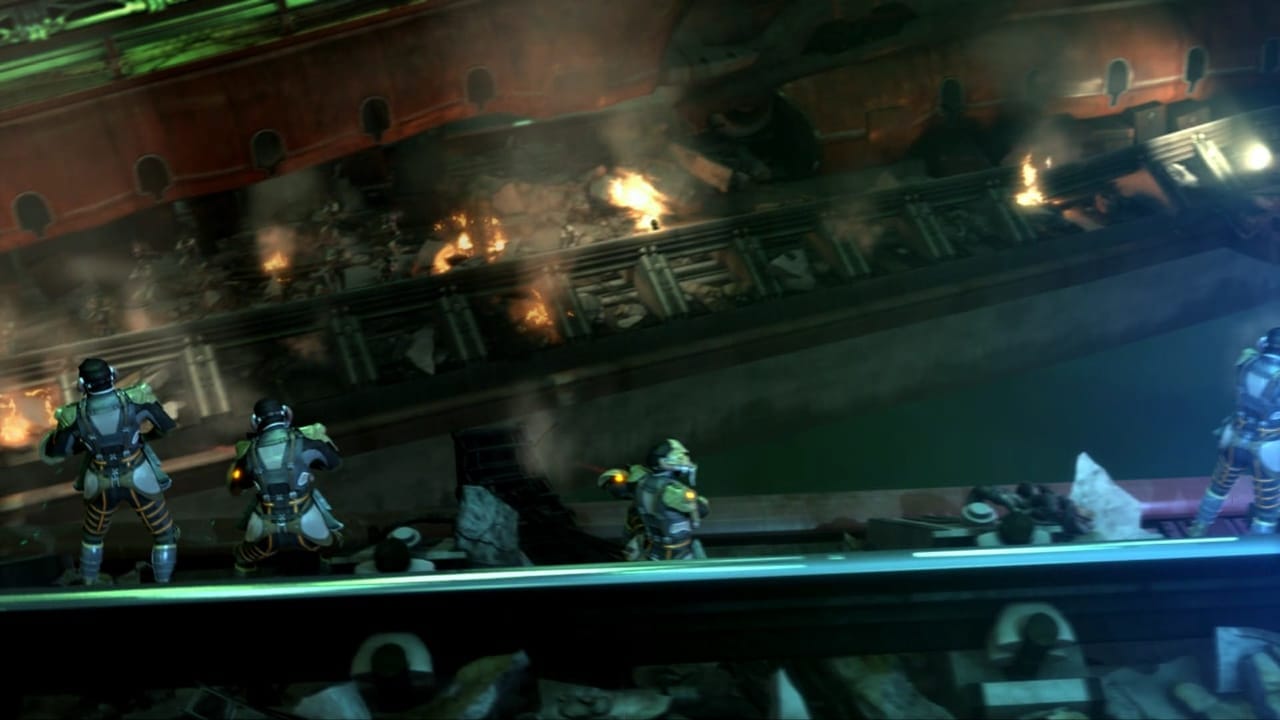
There’s so much that’s already been said about Final Fantasy XIII. Why even bother putting myself into the middle of this debate? Well, the truth is that I’ve played the game twice and have had yet to finish it. That may not sound surprising, but what might surprise you is that I didn’t hate it! I just got distracted by another game at some point and moved away from this one. However, that’s about to change. I’m going to give Final Fantasy XIII the deep dive it deserves and find out, for better or worse, if the game is worth playing.
I know my current feelings toward it, but there’s a lot of stuff I’ve forgotten since the last time I played it. So, because I have basically no sense of self-preservation, I’m getting right in the middle. Love it, hate it or somewhere in between, it’s time to lay this one to rest. Let’s dive into the deep end of Final Fantasy XIII!
Final Fantasy XIII - December 17th, 2009 (PlayStation 3, Xbox 360, PC, iOS, Android)
Version used for review: Steam port, 2014
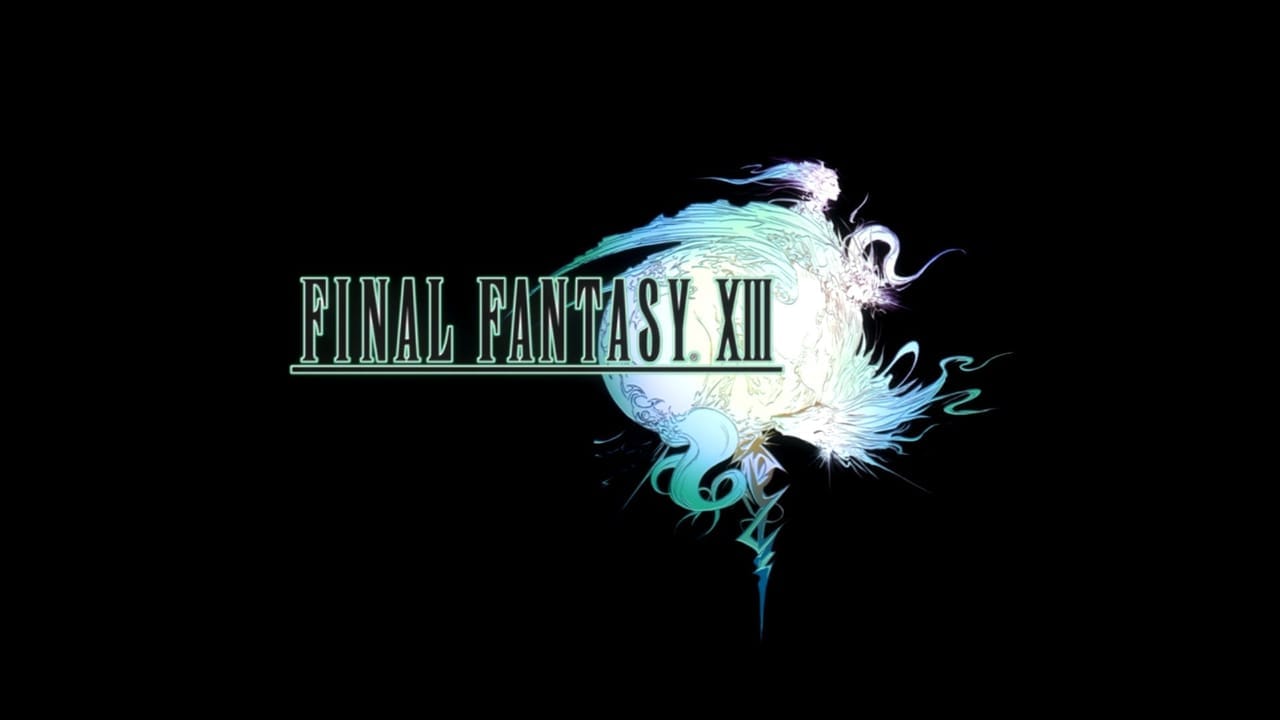
Story
“The thirteen days after we awoke were the beginning of the end.”
We begin Final Fantasy XIII on a train on a giant, floating city named Cocoon. Something isn’t quite right, as the people boarding are being guarded at gunpoint and are all covered in cloth. These people are being Purged, since they were in the vicinity of a godlike being from the horrible, scary, devilish Gran Pulse, the world below Cocoon. Fearing that these people may be contaminated and turn into monsters, the Empire has enacted the Purge, which surely isn’t as bad as it sounds!
We soon find that two of our protagonists are on this train: Lightning Farron, the pink-haired badass and Sazh Katzroy, the bumbling gunslinger. Not long after departure, Lightning starts to wreak havoc, using her blade to cut through the armed soldiers onboard. She and Sazh escape the train and go on the run, having been made immediately into fugitives of the law. So far, quite the intense opening!
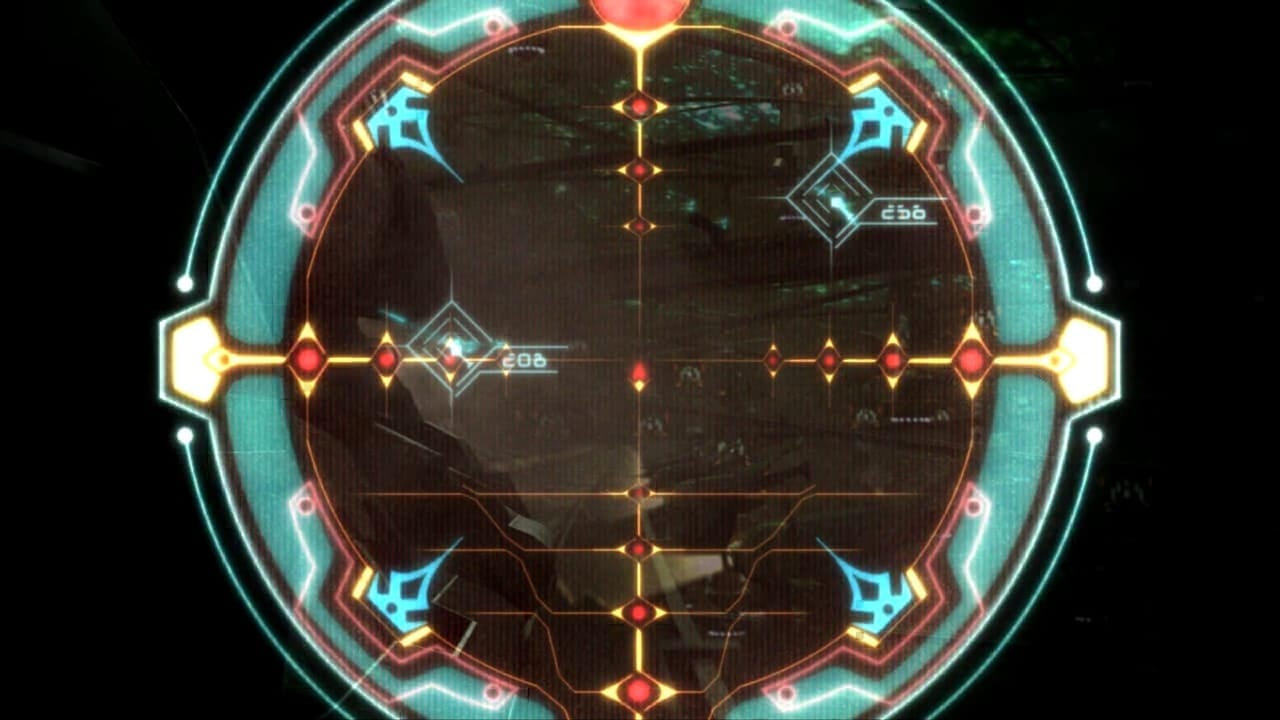
Next, we meet who will end up being more party members. In one scene, we meet the young Hope Estheim, a rather charmless little runt of a teenager. He’s befriended quite quickly by Oerba Dia Vanille (Vanille, for short!), an exuberant and bubbly young lady. They’re trying to make their way to find Hope’s mom, who has joined a Purge Resistance force led by the hothead Snow Villiers. Apparently, things are quite strained between the empire of Cocoon, headed by Primarch Galenth Dysley (who I and the internet lovingly refer to as Space Pope) and the people that he rules over.
In the ensuing firefight, things go horribly wrong and the bridge that Snow and his posse are fighting on starts to crumble. He attempts to save Hope’s mom, but he can’t keep her from falling to her death. Before she falls, she makes Snow swear to protect her son, to which he agrees.
Unfortunately, this plants the seed for what will become one of the most annoying subplots throughout the game up to about chapter 8 or 9 or so. Hope and Vanille make it to the battlefield just in time for him to see his mother die, and seeing as Snow was the one who recruited people, the youth blames him for her death and vows to himself that he’ll exact vengeance on Snow. Nevermind that people joined the Resistance of their own free will, as the game explicitly shows his mother volunteering in a cutscene and that Hope knows she willingly agreed to join…
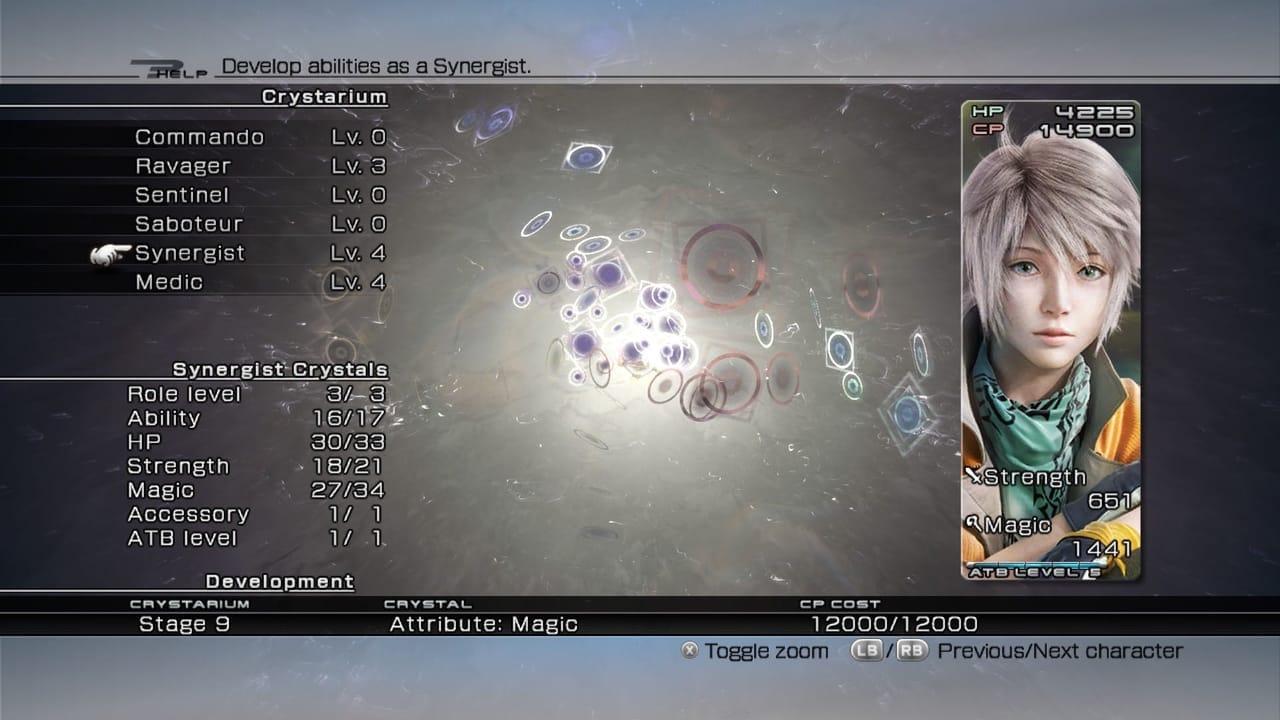
But before we get too far down that rabbit hole (don’t worry, we’ll explore it in a bit!), let’s get back on track. So Sazh and Lightning are on the run and eventually they run into Snow, who has found Hope and Vanilla and taken them under his care. They run into Serah Farron, Lightning’s sister and Snow’s fiancee, near the Gran Pulse fal’Cie’s temple that started all this madness to begin with. As it turns out, this is who Lightning has been searching for since the game’s beginning, and unfortunately her sister’s become a l’Cie.
So what is a fal’Cie? Well, it’s something akin to a godlike being. They help man exist at the cost of sometimes requiring “tasks” to be done. To do so, they brand humans with a mark on their body, marking them as a l’Cie. This makes them a servant to the fal’Cie, who then gives the l’Cie their Focus (their task) in a series of vague visions, with nothing else to go on beyond that. As time passes, the l’Cie markings start to cover more of their body. It’s here that the poor l’Cie has two very sucky options.
First, if you fail your Focus, you succumb. The l’Cie markings overtake you and you become a horrible monster called a Cie’th (someone went a little apostrophe-happy this game). There’s no hope for a Cie’th, and there’s no other option but to kill them. Now, if you succeed, things don’t actually get much better. Should you discover your Focus and complete it, you are rewarded with the awesomeness that is… slumber eternal as you’re encased in a crystal, until such a time as the fal’Cie needs you again with another Focus where the process repeats. Damn, being branded a l’Cie kinda sucks, no two ways about it.
Why do I tell you all this now? Well, Serah bringing the group together and asking them to save Cocoon was her Focus. Surprise! She crystallizes in front of everyone to their abject horror and they find themselves quickly branded by the fal’Cie Anima in the temple. They all have the same vague vision of Ragnarok, a horrible monster that is said to bring about the end of days. And worse yet, being branded by a Pulse fal’Cie more or less automatically makes them sworn enemies of Cocoon and its people.
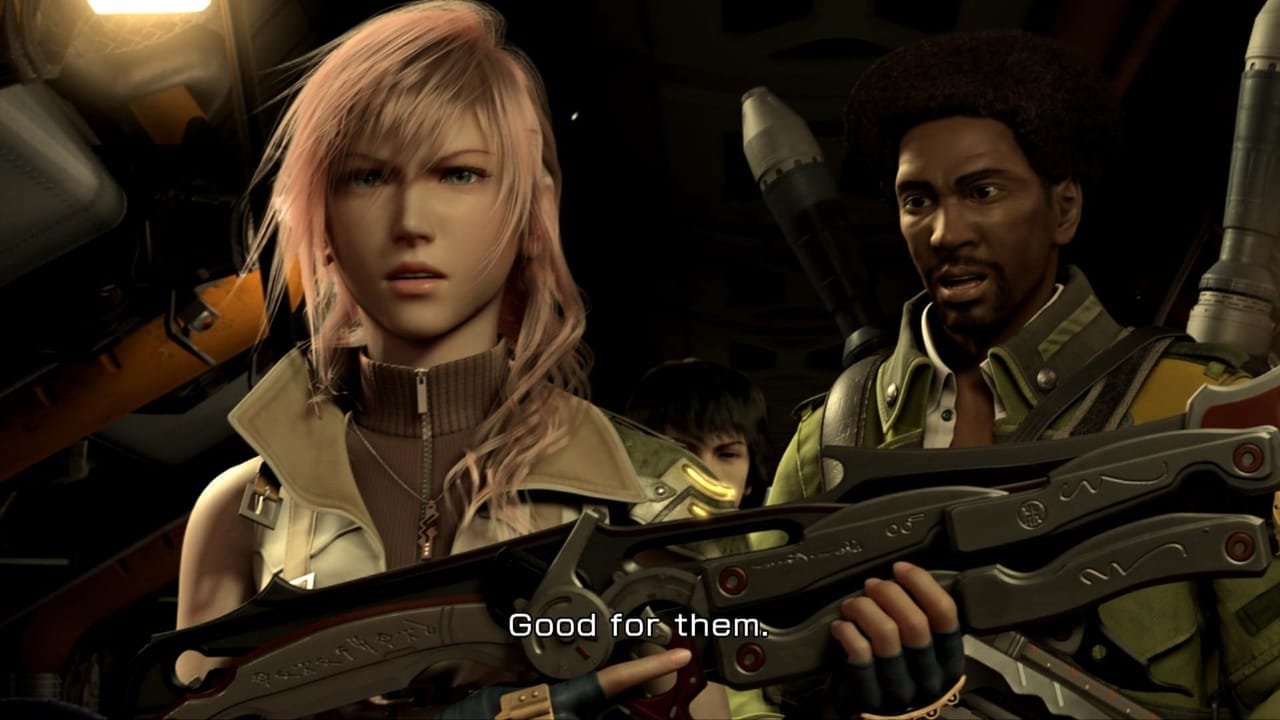
Here is where the story diverges. Believing that crystallization means death, the group’s priorities all shift. Snow chooses to stay with Serah, while Lightning runs off to go on a revenge-fueled rampage. Hope follows her, thinking she can teach him how to fight so he can kill Snow later. Vanille and Sazh essentially peace out, running in the opposite direction away from their fate.
Snow encounters soldiers of PSICOM, the elite sect of the Empire’s army, and in a moment of intense despair he encounters an Eidolon, or rather two, the Shiva Sisters. These beasts come to l’Cie in moments of hopelessness, and spur them back onto the right path. They force you to choose between life or death, as is made apparent when they cast Doom on Snow and make him fight them. Upon defeating them, the Sisters fuse together into a sweet-looking motorcycle which Snow can use, and he can summon them in battle to help.
Spoilers ahead for Final Fantasy XIII! If you don’t want to be spoiled, skip to the next bolded text!
Snow soon meets up with a woman name Oerba Yun Fang as well as Cid Raines, an inside spy playing the part of being on the Empire’s side, and it turns out they’re also trying to fight the Empire.
Eventually, on Sazh and Vanille’s side, we learn that Sazh is trying to reunite with his son Dajh. He took Dajh on a little trip to see a fal’Cie in work, as it powers the power plant of Euride Gorge. Unfortunately, we find out that as Sazh stopped by a souvenir shop to get him a gift, Dajh wandered off to see Kujata up close. The fal’Cie brands Dajh a l’Cie, causing him to be taken by PSICOM for testing.
So, the two head for a festival in Nautilus, where they actually run into Dajh and PSICOM… only for him to crystallize in front of them, having completed his Focus of finding supposed enemies of Cocoon. Assuming that means him and Vanille, he freaks out and starts to lose it, with PSICOM soldiers readying to take the two in.
Things take a turn for the even worse when Vanille, now totally guilt-stricken, reveals that Kujata only branded Dajh to defend itself against its supposed intruders from Pulse, the world below Cocoon that’s said to be a wildland full of crazed creatures. Those intruders were Fang and Vanille, both l’Cies from Pulse that had completed their Focus and were only awoken several days prior on Cocoon. Vanille had been in the Euride Gorge, which is what Kujata felt threatened by and branded Dajh.
This world-shaking revelation sees Sazh holding a gun to Vanille, who begs him to punish her for the pain she’s put him through. Unable to shoot her, he puts the gun to himself before lowering it and realizing that killing either of them wouldn’t change anything. Totally crushed, the two are taken in by PSICOM for execution instead.
While this has all been happening, Lightning has been teaching Hope how to fight with her knife. She lets him keep it, which… is a bad idea. Later on, during a raid by PSICOM, Lightning leads soldiers away and tasks Snow with getting Hope out of danger. As they run along and escape, Hope decides that it’s time to take revenge and blasts Snow with some fire (hehe).
Ready to take his life with the knife, an explosion knocks them both off the roof of the building they’re on. As they fall, Snow wastes no time in grabbing the boy to shield him from the ground. They both survive, with Hope now struggling to understand why taking revenge doesn’t make him feel better.
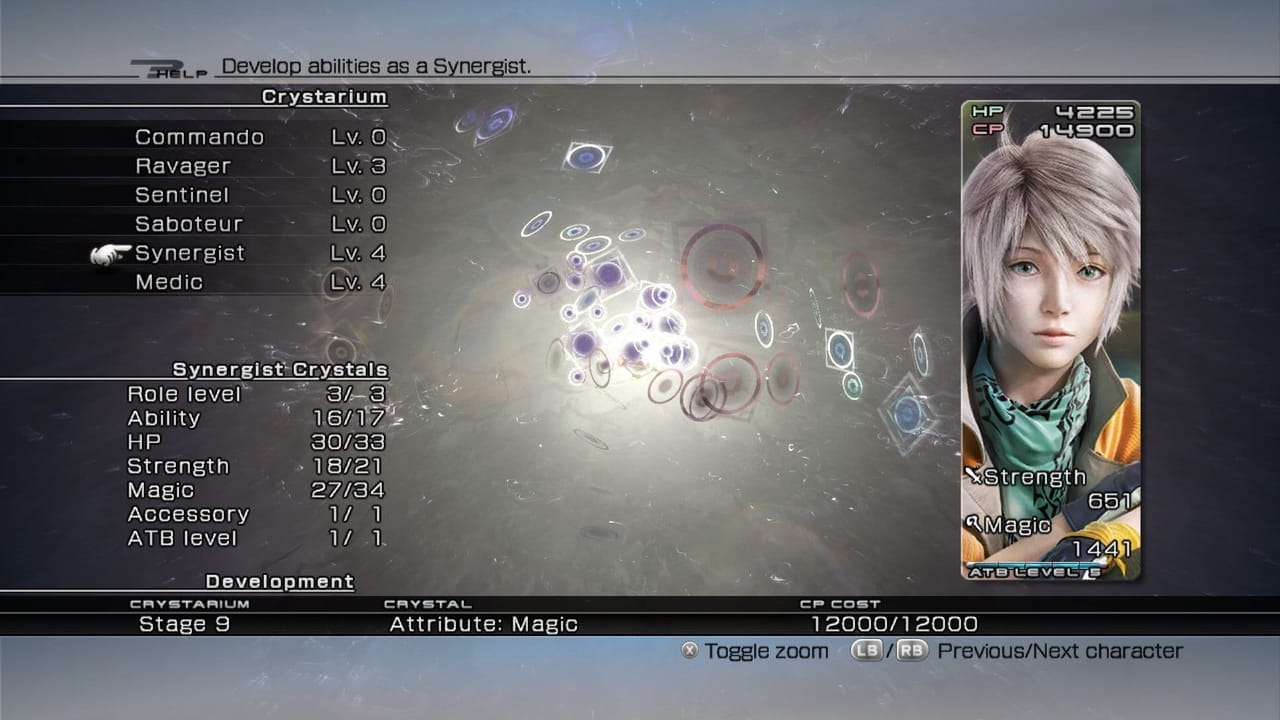
Soon, the remaining group meets up at Hope’s father’s house, where they break the news to him. Though distraught, he houses the group and thanks Snow for keeping Hope safe. Hope learns to accept that his mother chose her own actions, not Snow, and begins to move on from his place of deep-seated hate. However, they’re on the run again! PSICOM finds them and they’re forced to flee.
They escape to the Lindblum, the ship used by Fang, Cid and the rest of the resistance called the Cavalry. There, they see a newscast about a certain girl named Vanille, a Pulse l’Cie that is to be executed to show the Sanctum of Cocoon’s dominance. Obviously, they spring into action to save her and Sazh.
As the group tears through the Sanctum flagship, the Palamecia, Sazh and Vanille take charge and attempt escape on their own. They all meet up, and the six of them march forward to confront Primarch Dysley on the bridge of the ship. However, Dysley reveals that he is a fal’Cie himself, named Barthandelus.
This shocking revelation comes with an even bigger one: Serah’s Focus was not to ask them to save Cocoon, it was to bring them in contact with the Pulse l’Cie that must become Ragnarok and destroy Cocoon. Wait a minute, didn’t we just say earlier that Vanille is a Pulse l’Cie… oh no that’s bad.
They attempt to fight Barthandelus and do very little against him, so they choose to run for it instead and escape on a ship piloted via magic by Barthandelus. He wants them to see something, clearly.
The ship leads them to an Ark, a place where Pulse l’Cie can train to become stronger. It’s from Gran Pulse below, which means it’s very well-hidden. So close to the capital of Eden would cause rioting, so the Primarch has kept it a secret. He wants them to get stronger, to destroy Cocoon by killing Orphan, the being that keeps Cocoon in the sky over Gran Pulse. But why would he want that…?
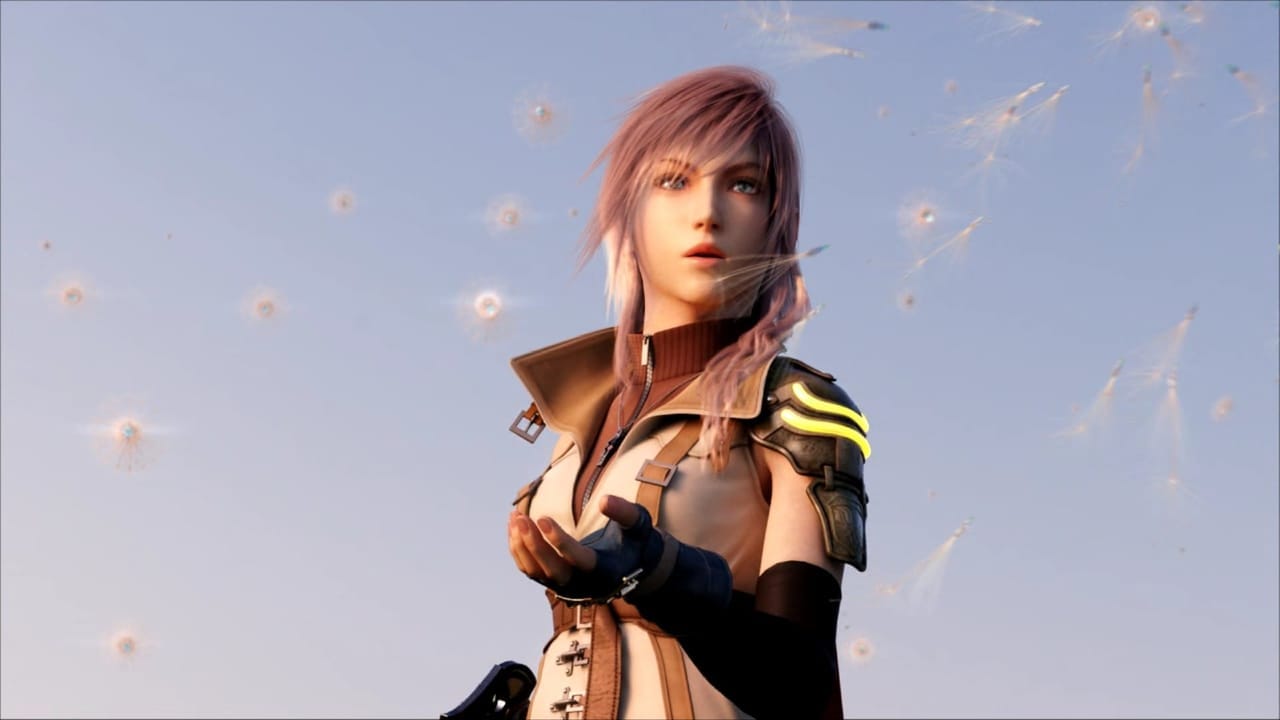
Anyway, they run into Cid again, who reveals himself to be a l’Cie under the control of Barthandelus. As it turns out, the creator of fal’Cie and humans is the same person, the Maker. Only by sacrificing the lives of everyone on Cocoon can the Maker return and prevent the world from falling into total ruin. However, as a human being before a l’Cie, he uses the last of his free will to fight Lightning and the group, reasoning that if they die, Cocoon will remain safe from Ragnarok’s wrath.
He gets destroyed, the group escapes down to Gran Pulse and decide this whole “become Ragnarok” is garbage and then decide to save Cocoon again. Geez, these guys are wishy-washy…
Anyway, the group traverses the gorgeous Gran Pulse for some way to save Cocoon and stop their Focus from coming to be. As they search, they meet with Barthandelus again. Here, he tells them that he revived Cid as a puppet to take over as Primarch. This is to cause chaos in the streets, with the Cavalry coming to wreak havoc for Cid’s supposed betrayal to the resistance. This will spiral into citizens and neighbors starting to kill each other out of fear.
Then, the resistance will infiltrate Eden, where the Primarch is based, and come across Orphan, destroying it and unwittingly killing everyone in Cocoon. For some reason, Barthandelus gives them another airship to go back to Cocoon and prevent this tragedy. What is going on in this game?!
The group reaches Cocoon and absolute chaos has broken out in the streets. Monsters from Pulse have invaded the city and are attacking anyone they see. The Cavalry is on the warpath in an attempt to kill Orphan. Honestly, this is one of the cooler sections of the game. A city overrun with monsters and in total pandemonium is quite the setpiece!
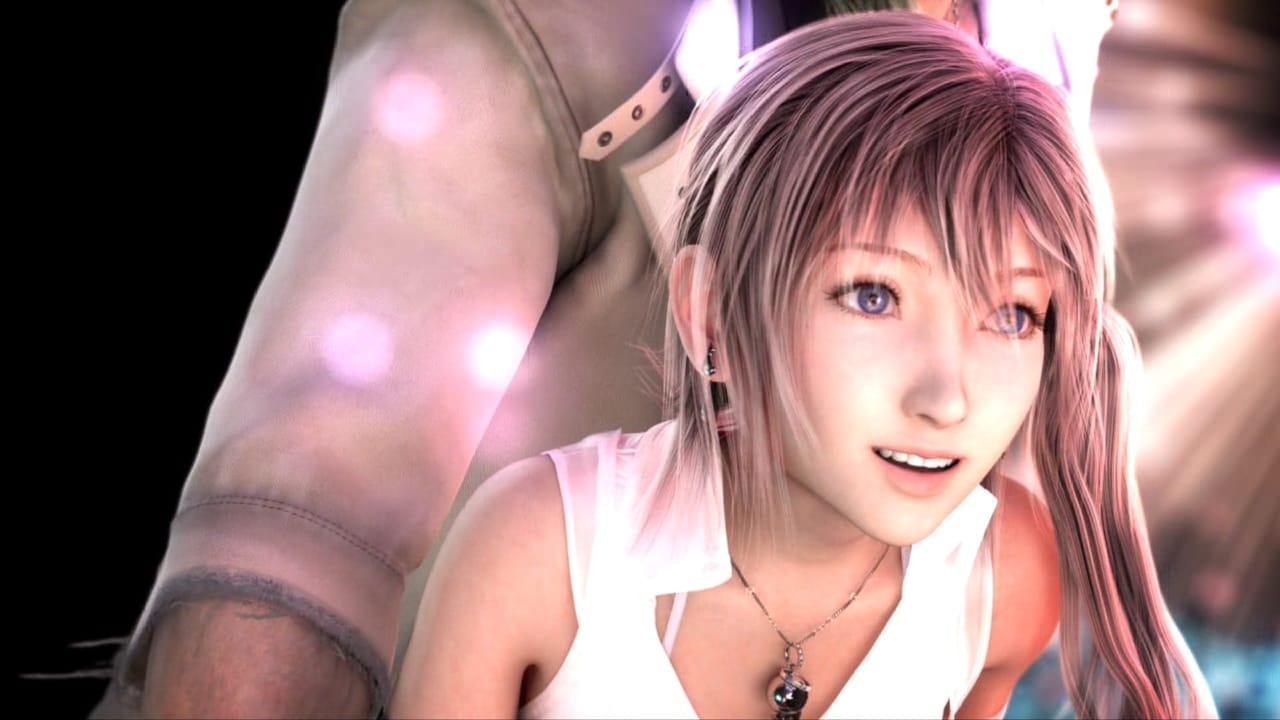
As the party carves a path toward Orphan, they must fight through Pulse monsters as well as Cie’th. They end up in Orphan’s Cradle, and it turns out that Barthandelus didn’t intend for them to actually reach Orphan. However, the group starts to fear for the future, and his plan is to use that to make someone become Ragnarok and destroy Orphan. They end up confronting Barthandelus one more time and kill him off, only for Orphan to tell them he wants to die too. Well, that would certainly gum up their plans! However, Orphan attacks them and they have no choice but to kill him.
As expected, the battery that powers all the fal’Cie is killed, and without him all of Cocoon begins to fall. Vanille and Fang choose to sacrifice themselves by becoming Ragnarok to actually save Cocoon, by crystallizing themselves as an enormous crystal pillar encasing the floating city. With the fal’Cie gone, everyone that is crystallized can be freed. This include Serah and Dajh. Yay, happy ending, even for the two who are forever crystallized in a pillar! With two sequels, I’m sure we’ll never see them again.
Spoilers have ended here. You can continue reading below!
So, it’s a pretty unique story to say the least. The fal’Cie and the l’Cie are interesting concepts, and seeing everyone react to such a curse in different ways is great. We see each person deal with their struggle and come to really feel for them.
Well, except for Hope. Both of his arcs feel downright annoying. I won’t get into major detail since we’re outside the spoiler section, but he has a main story arc and his own individual struggle after it. Both of them have the makings of a great character, but the way Hope is portrayed is awful. I despise his personality for the entirety of the game. The other six range from good to tolerable, but Hope and his stories fall far below the rest of the cast.
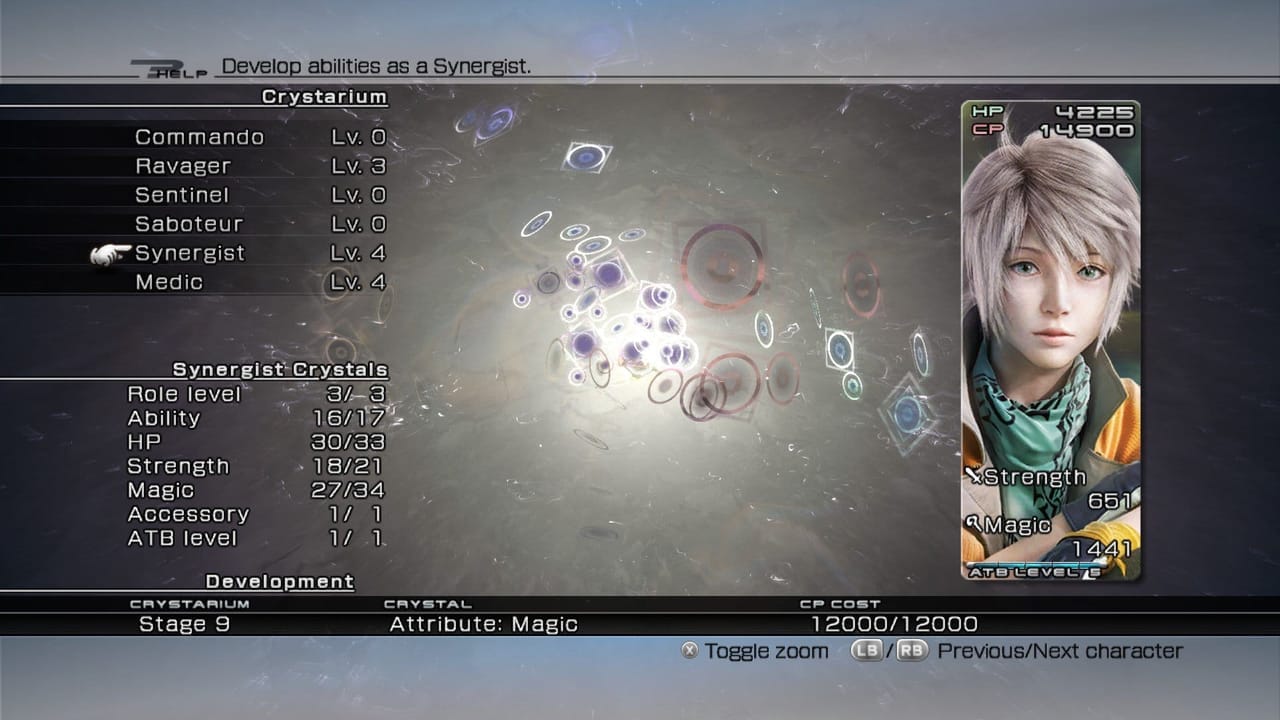
Thankfully, that’s not all the game has to offer. The other characters, as I said, are a range of good and decent characters, and the story itself is interesting enough.There is one pretty major, glaring flaw in Final Fantasy XIII’s tale, however. What you see in the cinematics can seem a bit confusing and disjointed at times, but the game does fill in the gaps for you… in the datalog.
As you play the game, you notice that the Datalog is constantly being updated. What Final Fantasy XIII doesn’t tell you, though, is that some pretty major plot and lore details are in the datalog as well. It doesn’t just recap events, it gives new info on the story and world as well. What the hell? Why would they do this?!
Destiny was rightfully reamed by players for making people look up important details and lore on the Bungie website. Final Fantasy XIII beat that game by a full five years. Yes, to get to the really interesting and engaging meat of the story, you get to read what amounts to digital book pages. While this game may have them in-game and not on a website, it doesn’t diminish the fact that the game passes off crucial extra details as part of a summary you wouldn’t normally read since you just played that section of the game.
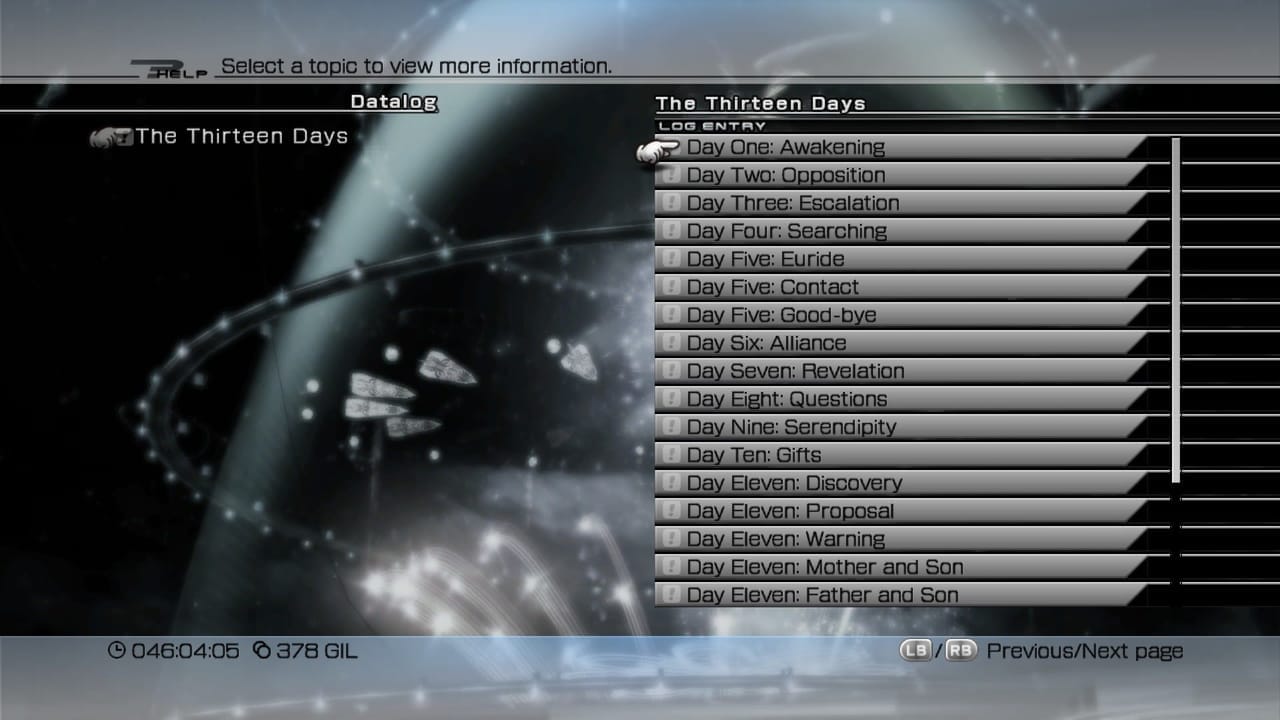
This is where a majority of the fighting over the story comes from. The plot really is a good one in my opinion. The problem is that a majority of it plays out long before the game actually begins, and we barely see any of it happen. It’s all played out in text, instead of actually engaging the player with it. In a large-scale JRPG series like Final Fantasy, you usually get to see and even play out a majority of the plot. However in Final Fantasy XIII, a solid half of the plot actually happens in text before the game begins. It’s a real shame, too, because from what I’ve read, I’d have loved to play that whole beginning out. However, we get what we get.
There, I ranted enough about the datalog. The characters and their arcs are generally very engaging (Hope’s notwithstanding), I love exploring the idea of a xenophobic, paranoia-stricken world being turned upside down and I really enjoy the buildup to the game. The one major downfall here, though, is the datalog that I mentioned. Put your story in the actual game proper, Square! Trust me, nobody will fault you for adding more content!
Graphics
“It also affords a splendid view of the impeding execution.”
With Final Fantasy XIII being the first main title to be in HD, Square Enix knew the stakes were high when it came to presentation. Especially after all the trailers and buildup, they knew that there was a lot of expectation from the company. Now, however you feel about the gameplay or story, sure, it’s difficult to deny that the game is gorgeous.
It feels like I keep repeating myself every time in this category, but it’s only because each game continues the trend of being absolutely stunning. At the time of its release, Final Fantasy XIII was easily among the best-looking games on the market. Even today, it holds up pretty well.
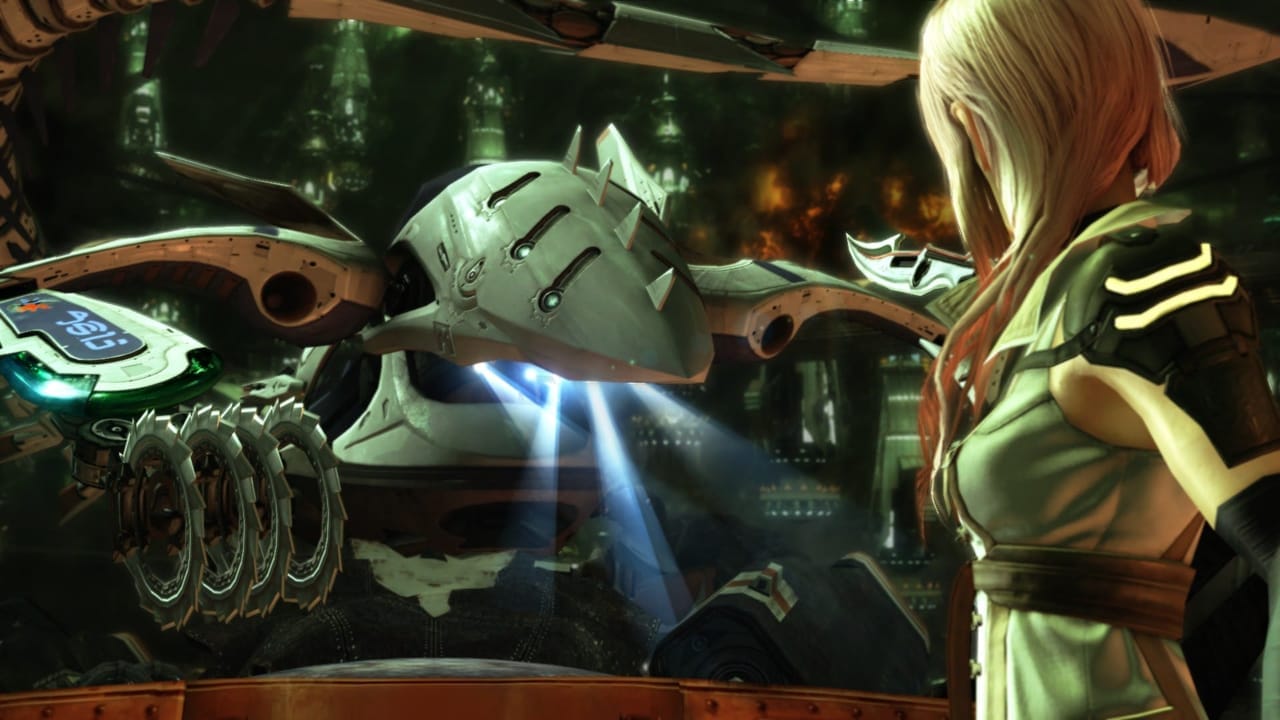
Though the paths themselves are somewhat limited for a majority of the game, the environments are still absolutely stunning. Bright, vibrant colors wash over every scene, making the game a visual delight. From the gorgeous green overgrowth of the Sunleth Waterscape to the ominous, alien whites and blues of the Gapra Whitewood, everything in Final Fantasy XIII is popping with detail.
Even when you get to a certain point of the game and the environments open up, the game retains its sterling presentation. The open fields, while fairly devoid of any major landmarks most of the time, are still breathtaking in scope. Basically, anywhere you turn, you’re gonna find something that makes you stop for a second and give at least a little “wow”.
The characters themselves are similarly stunning, but for perhaps different reasons. Most of the characters look fine with their designs and outfits, but it does suffer from a certain RPG trope. Namely, the NPCs all look a certain degree of normal, while the playable characters are all dressed rather… eccentric by comparison. For Fang and Vanille it could be forgiven for story reasons, but the others just stick out like a sore thumb. It’s not that they look bad by any means, just that for people on the run trying to hide… maybe don’t wear such vibrant oranges and blues and such?
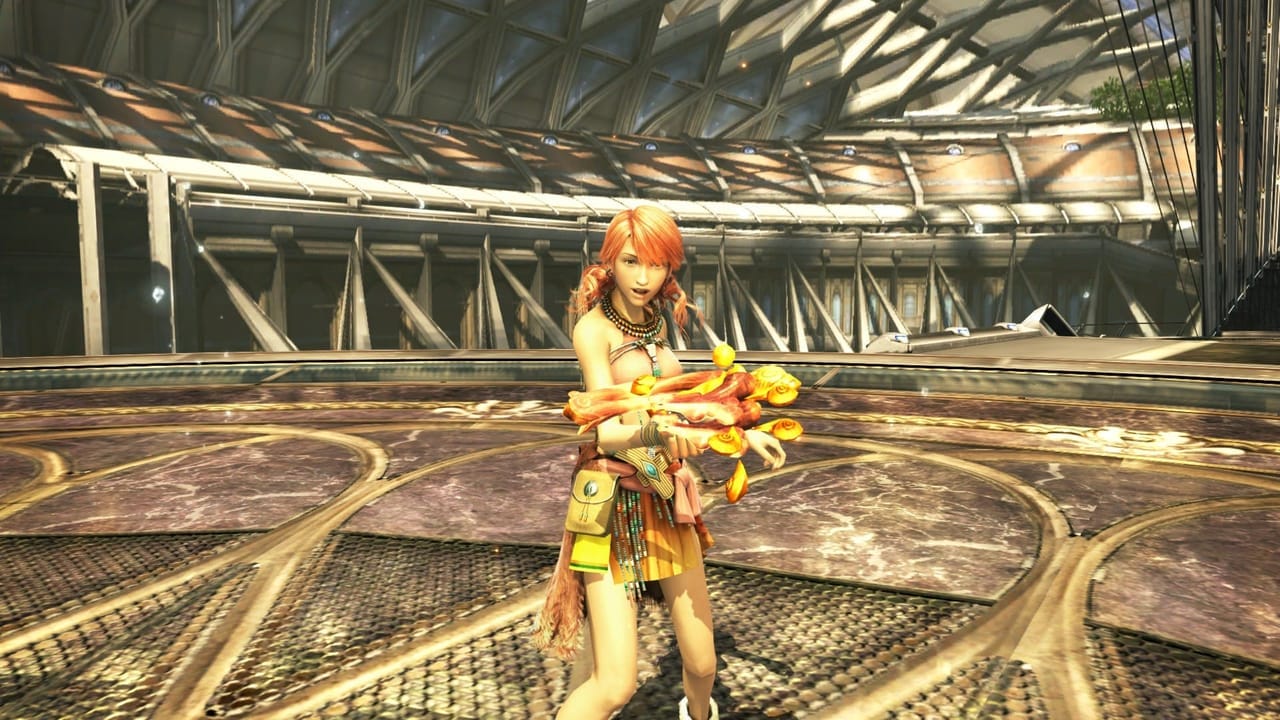
One last note: I played the PC version which despite being a low-requirement port, still has trouble hitting 60fps without some tweaking. You can easily get 60fps out of the port, it just requires a little troubleshooting on your part which can be annoying. It’s essentially such a low-spec port that some dedicated GPUs will actually go into low-power mode, which will affect performance. This doesn’t happen to everyone, but it did to me, and with a few minutes of fixing it, I was running a butter smooth game with no drops. Definitely worth mentioning here though!
As it stands, I get that they want the cast to look as unique and cool as possible though. I can forgive it just because they look great and the rest of the game looks stellar. The environments are eye candy, the characters are cool, the monsters range from your average RPG monsters to weird plant beasts to pissed off, rusty robots. It’s a neat blend, and as a whole Final Fantasy XIII continues the penchant of graphical quality the series has come to be known for. This is one category I don’t think is even up for debate.
Sound
“The clamor of this conflict rouses the Maker.”
To start off, I’d like to discuss the voice acting of the game. I admit right away, it’s a mixed bag. Some of the characters do great, while others simply aren’t as good.
For some, Lightning is a badass with a harsh attitude. For others, she’s needlessly annoying and angry for the sake of being angry. Ali Hillis, either way, portrays her extremely well. She’s snippy, a little bitter, and boy does she sound like it. Everything out of her mouth either drips sarcasm or venom, and whether or not you like her personality, the acting is done great.
For an example of someone that just annoys me, look no further than Hope Estheim. The murderous little snot comes across as nothing but whiny and rage-inducing. He sounds exactly how you expect a rebellious 13-year-old would, which hey… points for accuracy, but man if it isn’t grating. Other than that, most of the characters range from average to good performances!
Now, as I mentioned briefly last month, Nobuo Uematsu did in fact step in and help compose some of the soundtrack for Final Fantasy XII. “Some” meaning “one song”, but nevertheless he did contribute. However, Final Fantasy XIII marks the first main title in the series that Uematsu had exactly zero to contribute.
Instead, the main composer for Final Fantasy XIII was none other than Masashi Hamauzu. You may recognize him from Final Fantasy X, where he helped compose some tracks for the game. Here, he takes the reins and puts a variety of strings and brass. The main battle theme, Blinded by Light, is a great display of his general style.
https://www.youtube.com/watch?v=Th2jeYakyAY
And in fact, he also likes piano a lot. I was trying to find the closest theme to his style seen in Final Fantasy X, and I think The Hanging Edge is a good example. Tell me this doesn’t sound similar in some way to the final boss theme in X.
https://www.youtube.com/watch?v=TdsMe2fHZpE
However, much like Uematsu, Hamauzu knows when to switch things up. Sometimes the soundtrack calls for something a little less traditional orchestra. Here, in the garbage heaps of the Vile Peaks, you can hear a piece that’s certainly a bit more offbeat and strange than other areas. Hamauzu follows Uematsu in being great at fitting music to environments.
https://www.youtube.com/watch?v=0vvsxmJojUo
Nowhere is this ability to fit music properly more well-executed than the Sunleth Waterscape. Such a gorgeous vista requires a sunny, bubbly theme and Hamauzu has no problem delivering. You can tell just by the music, without seeing the game, the kind of environment that the music conveys. Perhaps my favorite track in the game, it’s upbeat and always a joy to listen to!
https://www.youtube.com/watch?v=5kkz6JwE3xE
Despite this, when things get serious, Hamauzu can ramp up the tension with his tension in response. Most of the battle themes are great in Final Fantasy XIII, including Desperate Struggle. I can’t really describe where this plays because it’s huge spoilers, but suffice it to say that yet again Hamauzu sets the scene. Any time you can tell the mood and tension of a scene or battle without even seeing it, that’s a success.
I’ll stop myself there, even though there are several more tracks I want to link. Final Fantasy XIII may not have the powerhouse work of Uematsu, but Masashi Hamauzu really steps into his own. He knew he had enormous shoes to fill and decided to step into them with the utmost confidence. The music of this game is excellent, full stop.
Gameplay
“Guess they're just doing what they can too. Trying to 'save the world.'”
When it comes time to actually play Final Fantasy XIII, the divided fanbase tends to split even further. Some say the battle system is deep and engaging, while others find it to be simply an auto-pilot style of combat. I’m speaking, of course, of the new ATB system.
The system used in Final Fantasy XIII is called the Command Synergy Battle system. It’s a variation of the good ol’ ATB system, and there are some good arguments in defense or in opposition of it. I’ll let you judge before I let you know where I fall on that scale!
So, you get an ATB gauge that’s divided into several segments. Over time, as you level your Crystarium (more on that in a bit!), you can add more segments to your ATB gauge. Now, in this game, skills and spells take up segments of the gauge depending on how powerful or useful they are.
Say you have a full ATB gauge. This means you can use a spell like Cure, and it’ll only take away one segment, so it only has to refill that much. You can also queue up a series of spells to use as soon as your gauge fills to the number of actions you want to perform, such as launching a barrage of attacks or a volley of spells at an enemy.
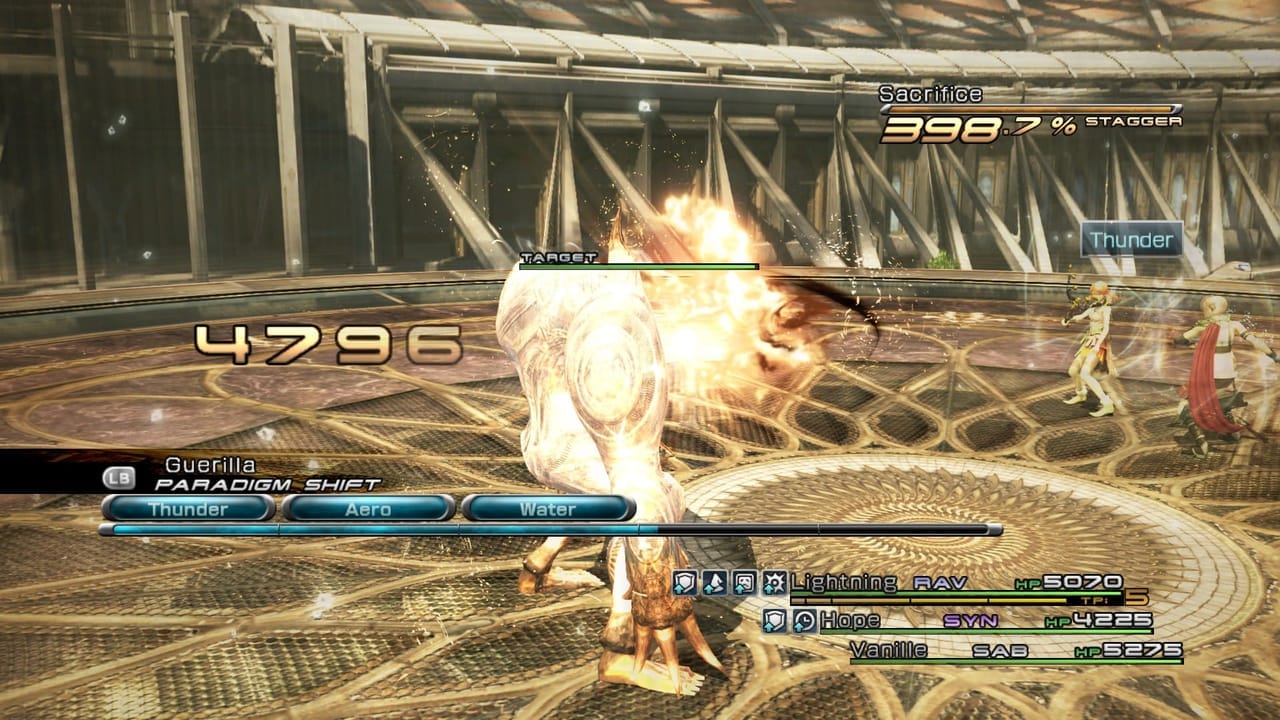
The issue that some take with this is the auto-battle button that’s first on the command list you can look through. As you learn more information about an enemy, whether by killing multiple of them or using Libra, the game will automatically set up a series of commands that it thinks would be the most useful. You can absolutely use this and it will work most of the time. However, I can safely say that later on, just pressing auto-battle will definitely get you killed.
You still have to use your brain a majority of the time later on. Yes, in the beginning you’ll find that it suffices, but I’d argue that’s true of a majority of the Final Fantasy titles. In the beginning, all you really have to do is play attack-to-win, or if you know the weakness, weakness-to-win. It’s not until later on in the game that the actual strategy comes into play, and I’d even say that you have to be a bit more tactical earlier on in Final Fantasy XIII.
Now, depending on how efficiently you defeat an enemy or enemies, you’ll get a grade out of five at the end of the battle. This determines what items you can get, as well as how much gil you receive from battles.
...Haha, I’m just kidding! Much like Final Fantasy XII or Final Fantasy VIII, you don’t actually receive gil from items. Instead, you’ll find lots of crafting materials that you can either sell, or use to enhance everyone’s weapons. However, there are many items that have no crafting purpose and are simply meant to be sold for money, which is nice.
For me, money wasn’t really an issue in XII. You always got enough drops to sell to have a healthy income. In VIII it was much the same, I knew most of the SeeD answers to get a solid regular income based on my test scores. However, Final Fantasy XIII ends up using money for a lot more stuff, and I found myself teetering on the edge of gil farming for quite some time. As for why, we’ll discuss it in more detail in the next section. Needless to say, however, it was annoying after a while.
Now, in addition to all this, the leveling system has changed as well. This time around, you will use the Crystarium to gain stats, spells, and skills. Depending on how well you fight in battle, you’ll receive more or fewer Crystogen Points. With these points, you can carve a path through the Crystarium and head for the top! Think of it like the Sphere Grid in X, but more or less a linear path. However, it makes up for this by allowing you to have six different sets of crystarium for each character: one for each class that you can build independently.
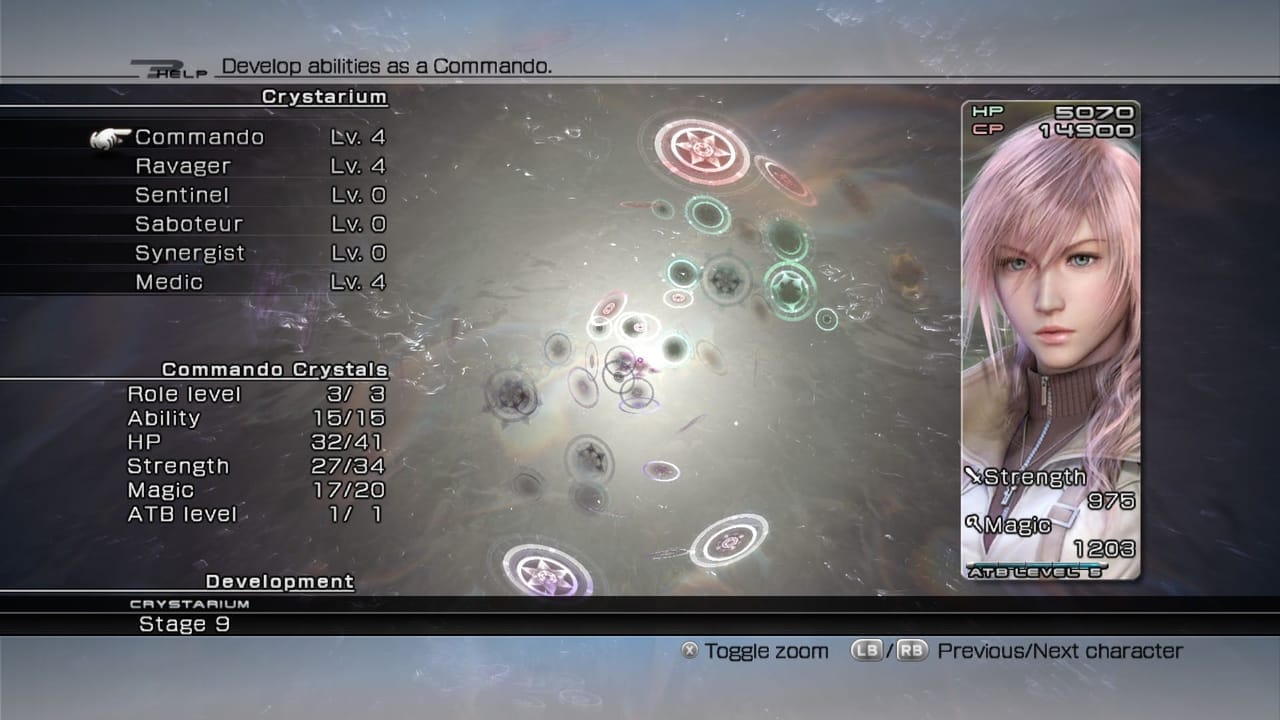
Oh, hey, there are totally classes by the way. In what just may be the biggest shift in the gameplay of Final Fantasy XIII, it introduces the Paradigm system. Later in the story, you unlock the ability to give jobs to each character. However, it’s much more than that.
You’ll notice when you’re assigning jobs to each character that there are six slots. As you assign jobs to each of the three characters you can play as at any given time, you’ll notice it gives the team a name that helps describe what the setup is.
You can assign jobs to characters in any number of ways. This is especially nice since everyone eventually becomes available to use any class. However, each character has one class that they excel in, with a skill or spell only they can get. As I mentioned before, you can get six slots to have a huge variety of possible parties at any given moment. It’s a really useful tool, and you’ll have to be smart about its usage as you play the game.
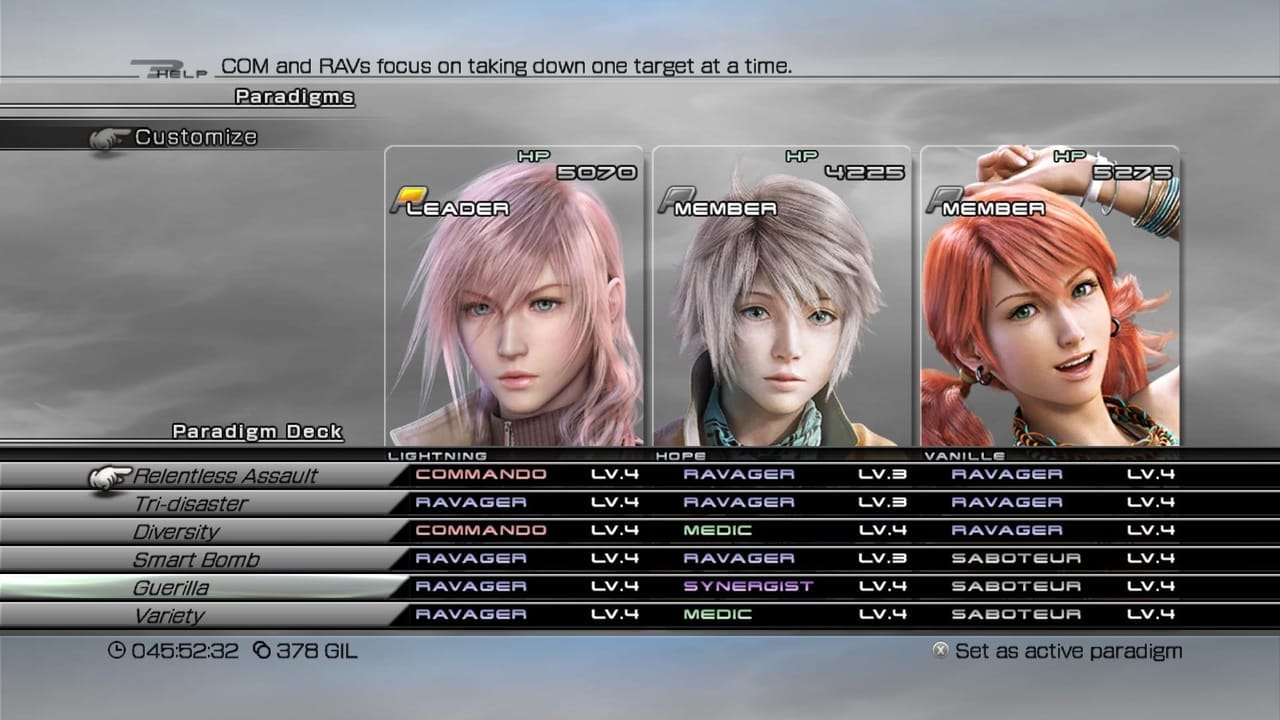
Say you have a healer, an fighter, and a mage (they have specific names, but I’ll get to that in a second). During battle, with the press of a button you can switch your setup to have a tank, healer and buffer to turtle for a moment and heal up. Then, switch to a mage, fighter and healer to continue your assault. It’s that simple when in battle!
The six classes are Commando, Ravager, Medic, Synergist, Saboteur, and Sentinel. Commandos are your fighters, focusing on heavy physical attacks and maintaining a Stagger gauge from depleting. Ravagers are mages, who focus on doing elemental damage and building your enemy’s Stagger gauge (more on that in a bit). Medics are exactly what they sound like.
Synergists are the ones who give you buffs to your damage, defense, Haste, etc. Saboteurs provide debuffs to enemies, including stuff such as lowered defense, lowered elemental resistance, slow, silence and much more. Finally, Sentinels are the tanks of Final Fantasy XIII. They have skills to try and antagonize enemies to focus attacks on themselves. In addition, they have skills to also help mitigate damage, such as Steelguard or even Counter to do heavy damage if attacked.
Now, earlier I mentioned a stagger gauge. You may notice that some enemies are heavily armored. Usually, it’s best to fill the enemy’s stagger gauge if this is the case. As you attack with a Ravager or a Saboteur, you’ll notice a gauge below their health bar filling up. This is the Stagger gauge, and once it’s full their defense will all but dissipate and your damage will be increased by the percentage shown until the gauge depletes.
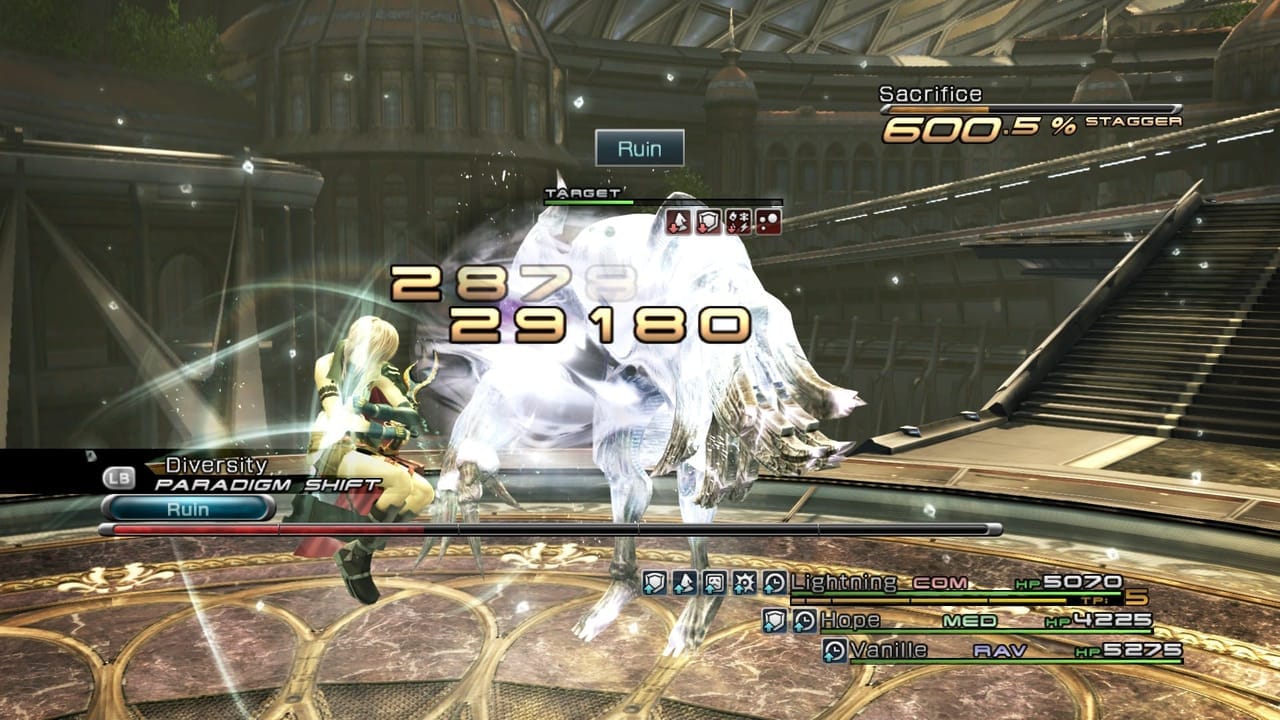
The problem is, when you attack with a Ravager you’ll see that the gauge depletes very quickly, leaving you unable to fill it. This is where Commandos come in. While elemental attacks fill the gauge, physical attacks from a Commando will temper the gauge, slowing its depletion and making it easier for the Ravager to build it up. It then becomes a balancing act as you attempt to hit that glorious Stagger, whereupon I usually Paradigm Shift to two Commandos and a Ravager. The Ravager continues to build the damage percentage during stagger while the Commandos go on an all-out assault. Watch in amazement as health bars disappear!
That just about covers the gameplay. Let’s move on now! There’s nothing else to discuss here. N-nothing else. Please let’s move on? Why hasn’t the next section shown up yet?
…
Alright, alright. I’ll discuss the elephant in the room: the “Hallway Simulator XIII” memes. If the story isn’t engaging you, that leaves mostly the gameplay. The truth is that Final Fantasy XIII does feature a heavy emphasis on linearity for a majority of the game. There’s no denying it.
While I agree that the game opens up later on, there’s no denying that for a solid 15-20 hours, the player’s agency in where to go is severely limited. I always say it’s because the story is about fugitives on the run who would have no chance or reason to explore anywhere. However, reason or no reason, it still is essentially a hallway for 75% of the game.
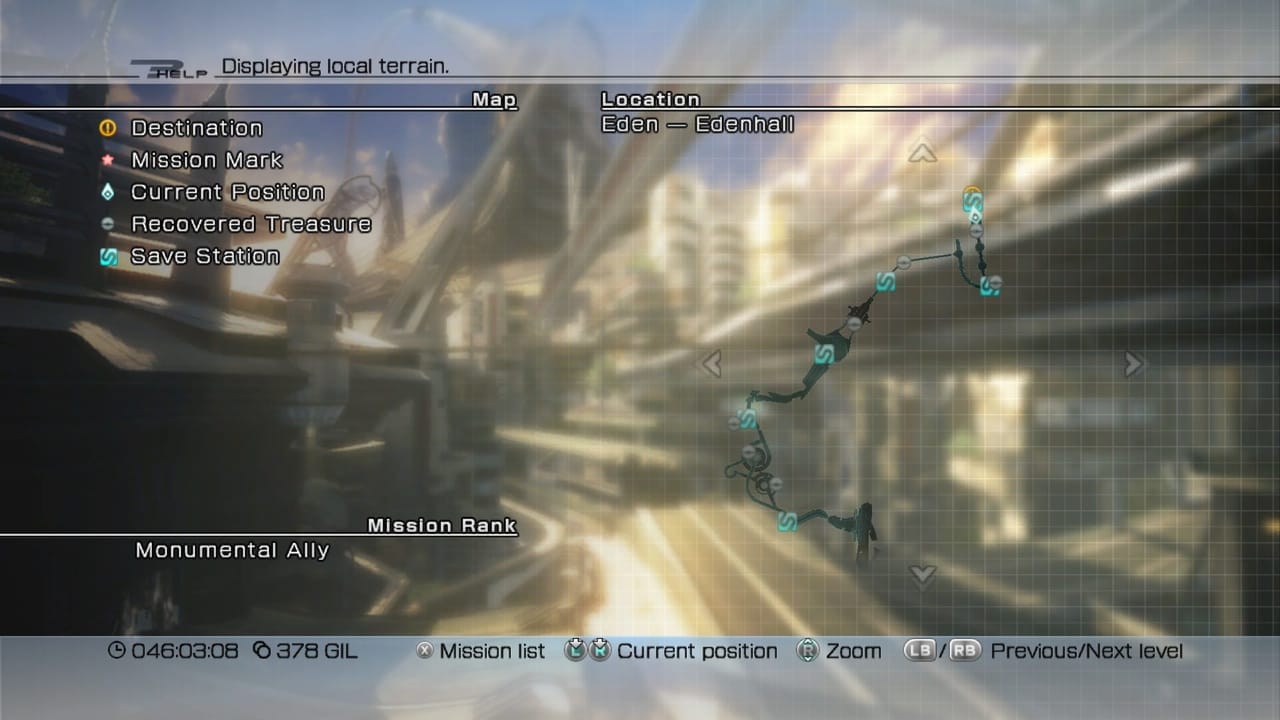
If it bothers you, I totally understand why. I wouldn’t say otherwise. It never really bothered me as the story keeps going smoothly, but I have no trouble understanding why it might piss someone off. A Final Fantasy game without much of a sprawling overworld or environment to explore? It’s strange and kind of uncomfortable.
I settled into it fairly quickly, but I don’t blame others for being mad about it. I will say that the environment does open up wide once you reach the last 25% of the game and that’s where a ton of postgame content is, but that doesn’t change the fact that the majority of the game is on a relatively straight line. This is perhaps the most divisive element of the game, and both sides have pretty reasonable points. In the end, it boils down to subjectivity. So be warned, for better or worse, the hallway jokes are pretty well-substantiated.
On top of that, it’s also very annoying that when the party leader drops, it’s game over. You only control one character in battle. If they get KO’d there’s no chance to switch to someone else or revive yourself. It’s just game over. I admit, this is pretty infuriating at times. It’s fixed in the sequel, but this isn’t the sequel, is it?
Aside from that, the gameplay I feel is pretty good. I like the Paradigm system as it allows you to craft a great set of jobs to use on the fly. The segmented ATB gauge is a great idea that allows for customization even in the heat of battle, and while a lot of the time it’s okay to use Auto-Battle, later on in the game you’ll have to be much more careful about what skills you use. The Crystarium is… okay, but I still prefer something like the Sphere Grid that offers a little more freedom of customization. It’s still more choice than a traditional leveling system since you can choose which class to level up at any given time, but it’s still a mostly linear path for each class.
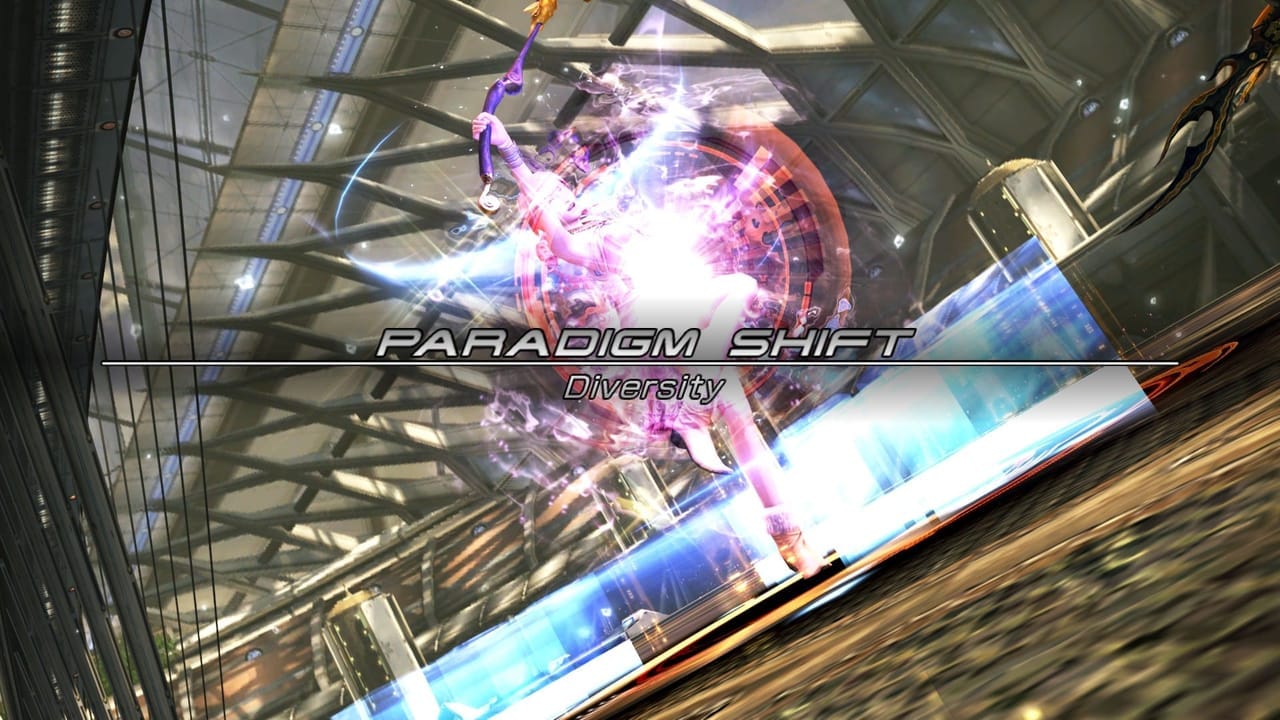
And as I said, that goes for the general game, too. I personally don’t mind the game being more focused on story than exploration. I also wouldn’t fault someone for being pissed about it either. Other than that, the gameplay is pretty solid, and perhaps the best part of Final Fantasy XIII.
Extras/Replay Value
“If nothing, we know Cocoon is safe for the time being. I'd say it's worth going to take a look.”
The truth is that Final Fantasy XIII contains quite the bevy of side content… once you manage to get to that wide open world I mentioned earlier. Upon your arrival there, you’ll start finding these random floating stones. These are called Cie’th Stones, and unfortunately they all have a sad story. They’re l’Cie who failed to complete their Focus and became Cie’th. Over time, they ran out of energy and eventually petrified. They ask you to complete their task for them, which is almost always to kill a monster around the area.
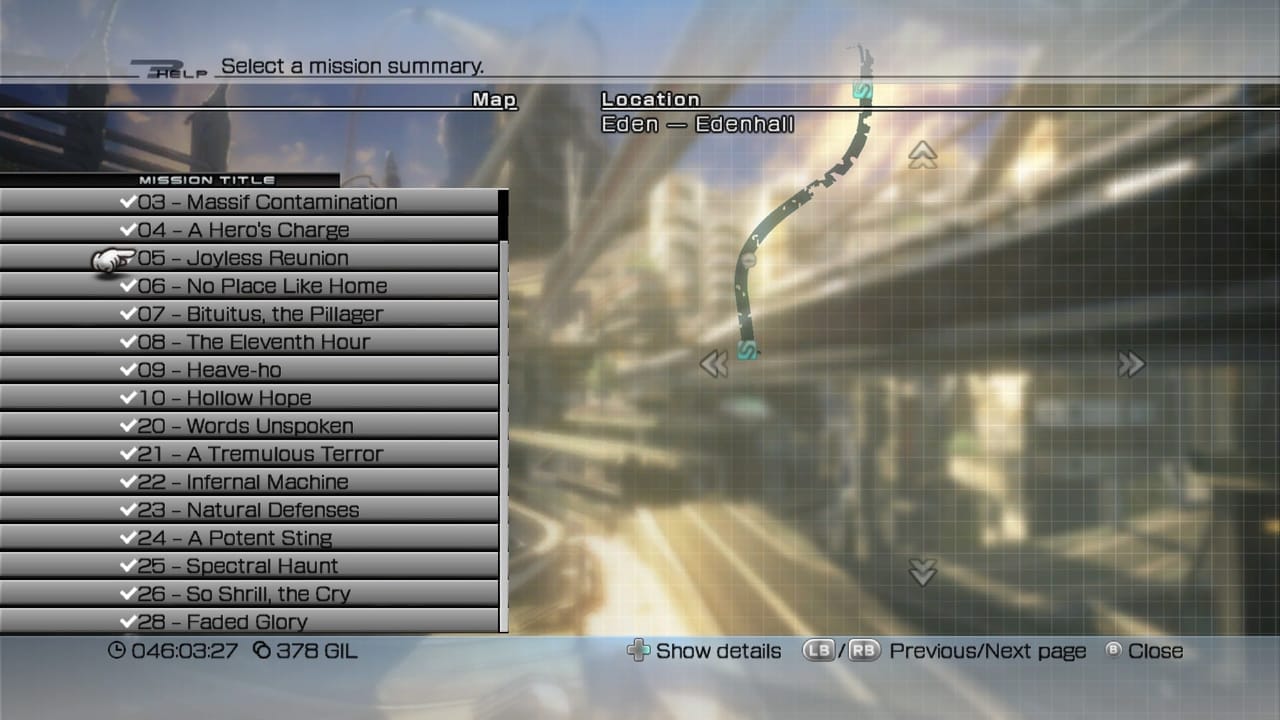
There are tons of these Cie’th Stones, and they range from small enemies all the way up to giant monstrosities. One of these is the game’s superboss, Vercingetorix. He’s a nasty flying beast, and without preparation and a mostly-full Crystarium you’re gonna have a bad time. However, there is actually another superboss not on the Cie’th Stone list: the Long Gui. This towering behemoth literally doesn’t fit on your screen when you fight him, and has over 16 million HP! For reference, I once tried to fight the Adamantortoise, which is a lesser version of the Long Gui. It stomped the ground one time at the start of battle and killed the entire party. It… it was bad, and I don’t have the courage to go after another one.
However, in order to have a chance to fight these guys, you’ll also need some good weapons. The weapon upgrading system in Final Fantasy XIII is extremely robust, and this is where a majority of your gil is going to go. You will grind for hours at a time for items to sell, in order to buy more items, in order to power up your weapons. Now, I recommend a guide for this, as getting everyone’s ultimate weapons is pretty much absurdly complicated otherwise.

You upgrade weapons and accessories by pumping them full of items that you get from battles or buy from shops. This will create an EXP multiplier depending on which items you use and how many you use at a time. After a certain level, you’ll need a special stone or some other item. This is to transform the weapon into yet another stronger weapon. Rinse and repeat from there until you get the ultimate weapon.
Needless to say, it’s insanely involved and I had more fun upgrading the Celestial Weapons overall in Final Fantasy X. There, it felt more like an accomplishment for some admittedly tedious tasks. Here, it’s just “grind items to grind gil to buy items to boost weapon, do this for hours on end”. I didn’t get much satisfaction from it at all, to be honest.
However, those are the two main extras for the game. Take it or leave it, it’s what Final Fantasy XIII offers. I admit, compared to the extras found in other games, I have a hard time saying this is the most exciting content. It’s nice that they have something, but it’s not the most engaging by far. I don’t mind the Cie’th Stones which mostly act as marks from Final Fantasy XII, but the weapon upgrading can get completely tiresome. It’s not exciting beating the snot out of the same enemies for hours at a time to get money. It’s just monotonous.
As it stands, Final Fantasy XIII could use a lot more varied extras. Compared to other titles in the series, it falls woefully short of a vast majority of them.
The Final Word
“Still happy you tagged along?”
I’m just going to say it: I would recommend playing Final Fantasy XIII. I think it’s a good game. Come at me, haters!
No, no, no. I totally understand the flaws of the game can make or break the game. I found that the hallway simulator didn’t bother me much, but the weapon upgrade system sure did! The Auto-battle didn’t really get under my skin, but you better believe the story being told through datalogs was grating! For every good thing I like about Final Fantasy XIII, there’s something that equally annoys me. It’s a lot like Final Fantasy II in that regard.
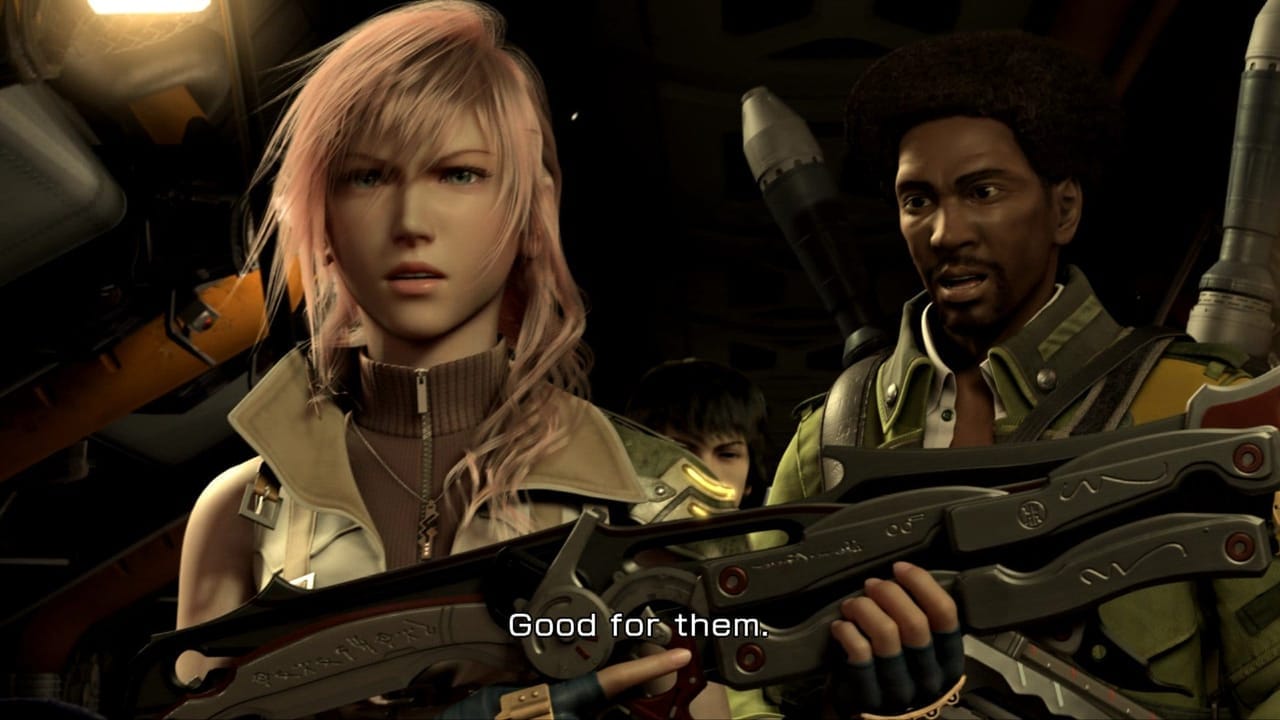
In some moments, the game shines. However, that shine quickly disappears as a flaw rears its ugly head, and it happens every time. However, unlike FFII, I can say that the pros outweigh the cons for Final Fantasy XIII. At least, for me. Again, the design decisions are a hot topic of debate for a reason, and I’m sure your mileage may vary.
For me, though? I enjoyed my time with the game. I wouldn’t ever go out of my way to complete it. That being said, as a story it does enough right to not be a waste of time. Just make sure you know what you’re getting into before you play it! You may find that you despise it otherwise. I never thought I’d have to make a PSA for a game, but I guess here we go: Your enjoyment of Final Fantasy XIII may directly relate to how much you know about the game going in. If only other people could share their opinions with you on the matter… oh wait.
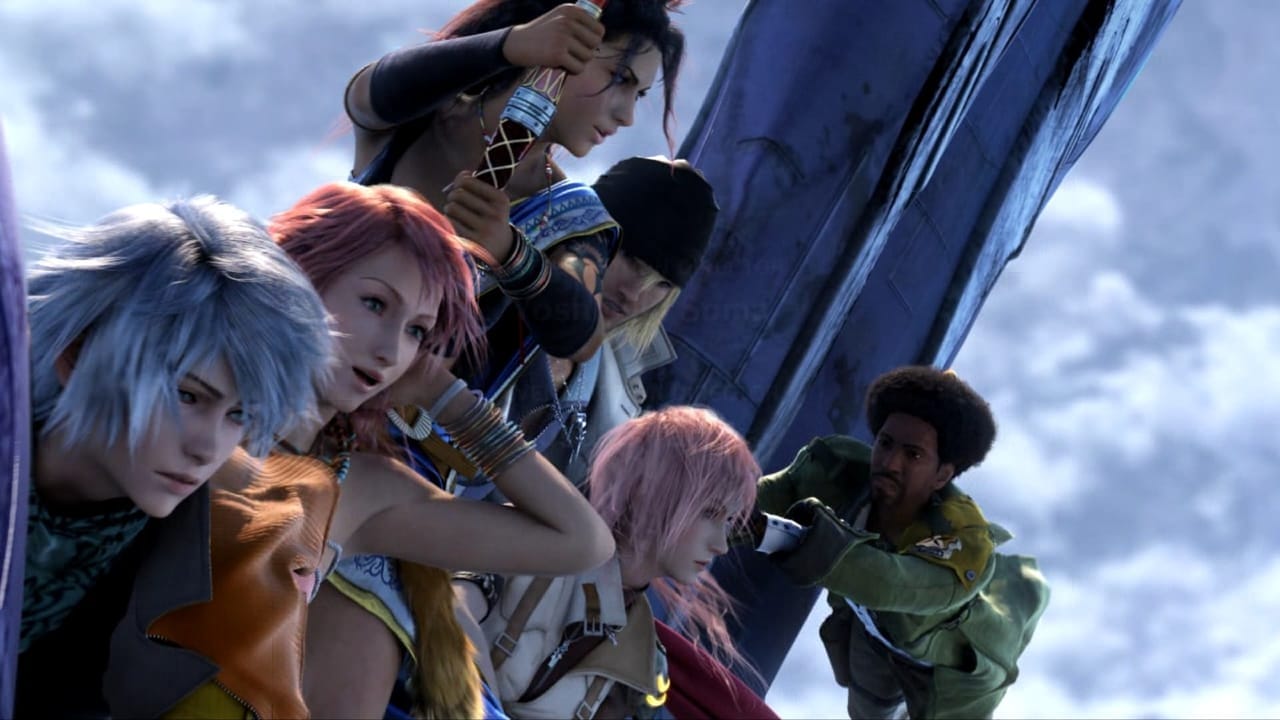
Have a tip, or want to point out something we missed? Leave a Comment or e-mail us at tips@techraptor.net
